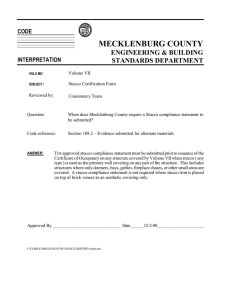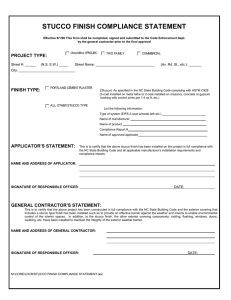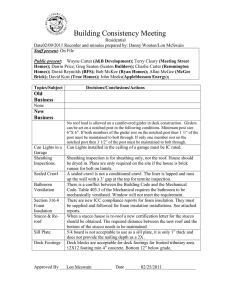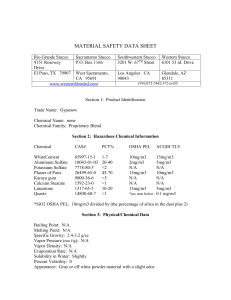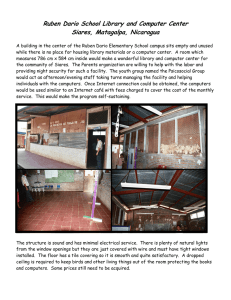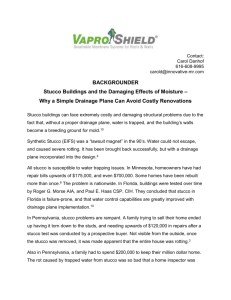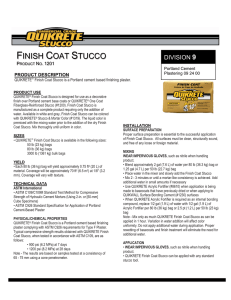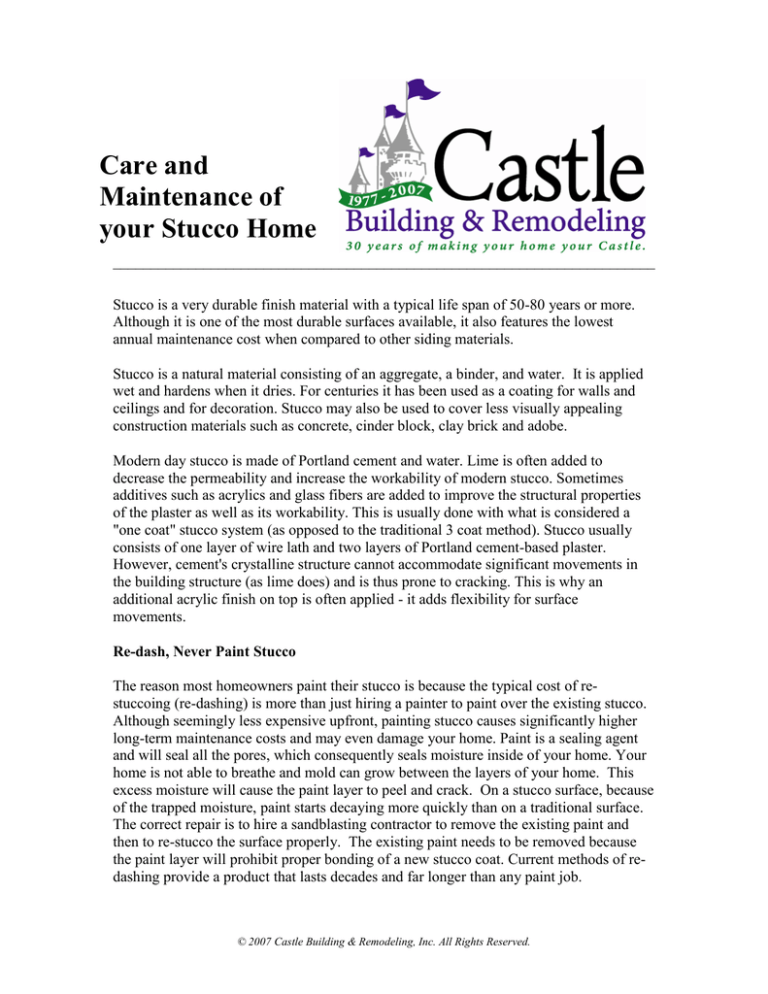
Care and
Maintenance of
your Stucco Home
________________________________________________________________________
Stucco is a very durable finish material with a typical life span of 50-80 years or more.
Although it is one of the most durable surfaces available, it also features the lowest
annual maintenance cost when compared to other siding materials.
Stucco is a natural material consisting of an aggregate, a binder, and water. It is applied
wet and hardens when it dries. For centuries it has been used as a coating for walls and
ceilings and for decoration. Stucco may also be used to cover less visually appealing
construction materials such as concrete, cinder block, clay brick and adobe.
Modern day stucco is made of Portland cement and water. Lime is often added to
decrease the permeability and increase the workability of modern stucco. Sometimes
additives such as acrylics and glass fibers are added to improve the structural properties
of the plaster as well as its workability. This is usually done with what is considered a
"one coat" stucco system (as opposed to the traditional 3 coat method). Stucco usually
consists of one layer of wire lath and two layers of Portland cement-based plaster.
However, cement's crystalline structure cannot accommodate significant movements in
the building structure (as lime does) and is thus prone to cracking. This is why an
additional acrylic finish on top is often applied - it adds flexibility for surface
movements.
Re-dash, Never Paint Stucco
The reason most homeowners paint their stucco is because the typical cost of restuccoing (re-dashing) is more than just hiring a painter to paint over the existing stucco.
Although seemingly less expensive upfront, painting stucco causes significantly higher
long-term maintenance costs and may even damage your home. Paint is a sealing agent
and will seal all the pores, which consequently seals moisture inside of your home. Your
home is not able to breathe and mold can grow between the layers of your home. This
excess moisture will cause the paint layer to peel and crack. On a stucco surface, because
of the trapped moisture, paint starts decaying more quickly than on a traditional surface.
The correct repair is to hire a sandblasting contractor to remove the existing paint and
then to re-stucco the surface properly. The existing paint needs to be removed because
the paint layer will prohibit proper bonding of a new stucco coat. Current methods of redashing provide a product that lasts decades and far longer than any paint job.
© 2007 Castle Building & Remodeling, Inc. All Rights Reserved.
Re-dash consists of a single layer of the Portland cement, with colorant applied to cover
and freshen the surface. Repairs are made to cracks and minor imperfections in the
surface and then the new coat is applied. This will provide a new look and keep with the
integrity of the existing finish. If a new texture is required, a thicker coat is required, and
can add additional expense.
Stucco Cracks
It is the nature of stucco to experience some cracking. These small cracks are normal and
do not require any maintenance or repair. If a crack exceeds 1/8 of an inch in width then
the crack should be repaired. Repairing stucco cracks is completed by adding a small
amount of stucco to the crack. Do not put caulk into the crack. If you experience a crack
wider than 1/8 of an inch please contact your contractor so the proper resolution can be
determined. Typically a larger crack can be broken back and patched or an expansion
joint can be added.
Yearly Inspection and Cleaning of Stucco
Stucco should be inspected annually for holes, significant cracks, or separations. If
stucco repairs are needed, it is important to have the repairs completed in a timely fashion
to prevent damage to your home.
A mild cleaner and water can be used to remove most stains. Pre-wetting the surface will
overcome some absorption of dirty wash water from being absorbed back into the dull
finish. Use of a garden hose and a jet nozzle in combination with a mild cleaner will
clean effectively. Do not hold the nozzle to close to the surface because the high pressure
may erode some of the finish. Pressure washers are not recommended because they will
erode the finish and can cause damage.
Stucco Coloration
Stucco comes in an infinite number of colors. These colors are made by placing an
additive into the cement mixture prior to application. The color is throughout the layer
and will not fade like a painted finish. The full curing time for stucco is typically several
years. During this time you will notice several color changes from dark to light, and then
back to dark as the finish sets and the excess moisture evaporates.
A typical stucco application requires a 30 day cure time between the first application
and the final finished coat. It is required that the final coat be done in dry warm
weather. Your stucco contractor should return after the 30 day cure cycle is complete.
© 2007 Castle Building & Remodeling, Inc. All Rights Reserved.
Decorative Items
The stucco on your home has been installed to stop water penetration. If incidental water
does enter through the stucco, a water-resistant membrane installed behind the stucco will
prevent it from entering your home and causing damage. It is essential not to penetrate
the stucco wall or the weather-resistant membrane with nails, screws, staples, or any
other fastener. Should it be required to attach items to your stucco walls, it is important to
hire a professional craftsman to ensure that the proper hardware fasteners are used.
Water and Sprinkler Systems
Gutters or sprinkler systems should direct water away from the stucco walls of your
home. The continual spraying of water onto stucco walls can damage stucco, create
stains, and allow green algae to grow on stucco walls.
Windows, Doors, and Other Penetrations
Where stucco meets a window, door, electrical box, dryer vent, or any other wall
penetration, you may notice a small expansion gap. Gaps are normal and should be
expected since dissimilar materials expand at different rates. Such gaps can allow for
excessive amounts of water to get past the stucco and therefore should be caulked on an
annual basis. Using a quality tube caulking from your local hardware store, apply the
caulk to the cracks using a small putty knife or your finger to ensure it fills the gaps.
Several weepholes are at the bottom of each windowsill. They allow water to exit from
the windowsill track. Using a small pin or paperclip annually inspect these holes to
ensure they are clear of debris.
© 2007 Castle Building & Remodeling, Inc. All Rights Reserved.

